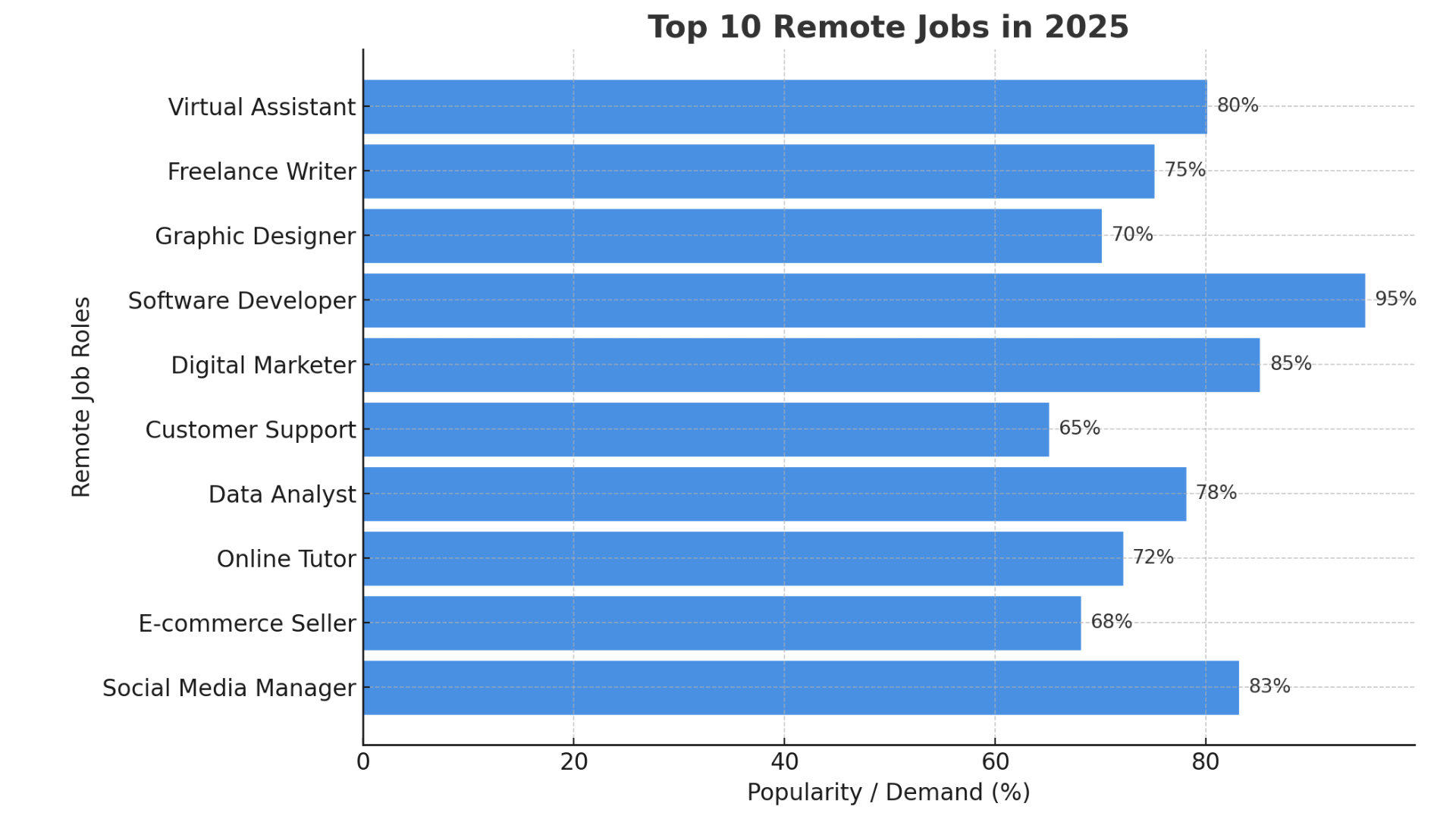Remote Work & Productivity
Remote Work From Home Jobs: The Ultimate 2025 Guide

Introduction
The modern workplace has undergone a massive transformation in the past few years. What was once considered a “luxury” or “side option” working from home has now become a mainstream career path. Remote work is no longer limited to freelancers or digital nomads; instead, it has become an essential part of global employment.
Today, companies of all sizes hire remote employees, and job seekers are increasingly looking for opportunities that allow flexibility, independence, and better work-life balance. If you’ve been searching for ways to break free from the traditional 9-to-5 office grind, remote work from home jobs might be your golden ticket.
This blog explores everything you need to know about remote jobs the benefits, challenges, top industries, skills needed, and how to land your dream work-from-home career in 2025.

Why Remote Work Is Booming
Several factors explain the global boom in remote work:
- Technology Advancement
High-speed internet, video conferencing tools, and cloud-based software have made it easy for employees to collaborate from anywhere in the world. - Pandemic Acceleration
COVID-19 forced millions of people into remote work. Even after restrictions lifted, both employees and employers realized the benefits of staying remote. - Cost-Saving for Companies
Businesses save money on office rent, electricity, and other overhead costs by employing remote workers. - Global Talent Pool
Companies can now hire the best people regardless of geography, giving them access to a wider range of talent. - Employee Demand
Workers increasingly value flexibility, independence, and a healthier work-life balance, making remote jobs highly desirable.
Benefits of Working From Home
1. Flexibility
Remote jobs often allow you to design your own schedule. Night owls and early risers can both perform at their peak productivity times.
2. Work-Life Balance
No more spending hours in traffic or crowded public transport. Remote workers have more time for family, hobbies, and self-care.
3. Global Opportunities
You’re not limited to your local job market. A professional in Pakistan, for example, can work for a U.S. or European company without relocating.
4. Increased Productivity
Studies show many employees are more productive when working remotely due to fewer office distractions.
5. Cost Savings
Workers save money on commuting, office clothes, and daily lunches, while employers save on office expenses.
Challenges of Remote Work
While appealing, remote work isn’t without hurdles.

- Isolation: Lack of face-to-face interaction can make some workers feel lonely.
- Distractions at Home: Kids, pets, or household chores can interrupt productivity.
- Overworking: The line between work and personal life can blur, leading to burnout.
- Security Issues: Remote jobs often require strict cybersecurity measures.
- Communication Gaps: Misunderstandings may occur due to virtual collaboration.
Fortunately, with discipline and proper tools, these challenges can be managed effectively.
Top Remote Work From Home Jobs in 2025
Remote jobs span across industries. Here are the most popular and in-demand remote work opportunities:
1. Virtual Assistant
Virtual assistants handle tasks such as scheduling, data entry, email management, and customer support. This role is ideal for organized individuals with strong communication skills.
2. Freelance Writer / Content Creator
From blogs to website copy, companies are always in need of fresh content. Skilled writers can earn a steady income through freelance marketplaces or direct client contracts.
3. Graphic Designer
Creative individuals can work remotely designing logos, websites, marketing materials, and more. Tools like Canva, Adobe Illustrator, and Photoshop make remote collaboration seamless.
4. Software Developer / Programmer
One of the highest-paying remote jobs, coding allows you to work with global companies. Skills in Python, JavaScript, and mobile app development are in demand.
5. Digital Marketer
Businesses depend on online visibility. Digital marketers specialize in SEO, social media, paid ads, and email marketing all of which can be done from home.
6. Customer Support Specialist
Remote customer service roles are popular. You help clients via chat, email, or phone while working from anywhere.
7. Data Analyst
Companies generate massive amounts of data daily. Analysts interpret this data to help businesses make better decisions.
8. Online Tutor / Teacher
With the rise of e-learning, teachers can instruct students worldwide. Platforms like VIPKid, Preply, and Chegg Tutors make it easy.
9. E-commerce Store Owner
Selling products on Shopify, Amazon, or Etsy has become a booming business. Many entrepreneurs run entire stores from home.
10. Social Media Manager
Brands need professionals to handle their online presence. Managing Facebook, Instagram, LinkedIn, and TikTok pages remotely is a highly demanded role.
Best Platforms to Find Remote Jobs
Here are some trusted platforms to kickstart your remote career:
- Upwork : Freelancing platform for writers, marketers, developers, and more.
- Fiverr : Great for freelancers offering creative and technical services.
- LinkedIn : Many companies post remote opportunities with clear job tags.
- Remote.co : Exclusive listings of remote work opportunities.
- Flex Jobs : Curated remote and flexible jobs across industries.
- Indeed : Search for “remote” or “work from home” jobs.
- We Work Remotely : Popular for tech, design, and customer support jobs.

Essential Skills for Remote Workers
Success in remote jobs requires more than technical knowledge. Here are must-have skills:
- Time Management : Ability to structure your day effectively.
- Self-Motivation : Remote workers must stay productive without supervision.
- Communication Skills : Clear writing and speaking to avoid misunderstandings.
- Tech Proficiency :Comfort with remote tools (Zoom, Slack, Trello, Google Workspace).
- Adaptability : Ability to adjust to different time zones, teams, and work cultures.
Tools That Make Remote Work Easier
- Zoom / Google Meet : Video conferencing.
- Slack / Microsoft Teams : Team communication.
- Trello / Asana : Project management.
- Dropbox / Google Drive : File sharing.
- Time Doctor / Toggl :Time tracking.
Tips to Succeed in Remote Work
- Create a Dedicated Workspace : Avoid working from bed; set up a home office.
- Set Boundaries : Establish clear start and end times.
- Stay Connected : Regularly check in with colleagues to avoid isolation.
- Invest in Good Internet & Equipment : Smooth workflow requires reliable tools.
- Keep Learning : Upskill through online courses to stay competitive.
The Future of Remote Work
Remote work is here to stay. Experts predict that by 2030, over 70% of professionals will work remotely at least part-time. Companies are redesigning operations to prioritize flexibility. Hybrid work models will also dominate, combining remote and in-office schedules.
This trend benefits employees, businesses, and even the environment — reduced commuting means less traffic and lower carbon emissions.
Conclusion
Remote work from home jobs have opened up a world of opportunities for professionals everywhere. Whether you’re a creative, a tech expert, a teacher, or a marketer, there is a remote career waiting for you.

By understanding the benefits, challenges, and skills required, you can position yourself for success in this new world of work. The future is flexible, digital, and borderless and remote work is leading the way.
Remote Work & Productivity
Understanding a Hostile Work Environment: Causes, Signs, and Solutions

Introduction: When Work Turns Toxic
A workplace should be a place of productivity, collaboration, and growth not fear or discomfort. Unfortunately, many employees around the world face challenges that go beyond everyday stress. When negativity, discrimination, or harassment become persistent, it creates what’s known as a hostile work environment.
A hostile work environment occurs when an employee feels intimidated, unsafe, or emotionally drained due to inappropriate behaviors or attitudes at work. This can come from supervisors, coworkers, or even customers. The effects go beyond discomfort they impact mental health, job performance, and overall well-being.
In this guide, we’ll explore what exactly defines a hostile work environment, its legal implications, examples, and strategies for addressing and preventing it.
What Is a Hostile Work Environment?
A hostile work environment is one where harassment, discrimination, or abusive conduct make it difficult for an employee to do their job comfortably. It goes beyond simple rudeness or occasional conflict the behavior must be severe, repetitive, and create a toxic atmosphere.
Legally, under employment laws in many countries (such as the U.S. Equal Employment Opportunity Commission, or EEOC), a hostile work environment often involves harassment based on protected characteristics, including:

- Race or ethnicity
- Gender or sexual orientation
- Religion
- Disability
- Age
- National origin
However, even if it’s not legally classified as harassment, an ongoing pattern of bullying, intimidation, or verbal abuse can still create a hostile workplace culture that damages morale and productivity.
Key Characteristics of a Hostile Work Environment
To identify a truly hostile environment, consider the following traits:
- Repetitive Misconduct:
One-time incidents rarely qualify. The behavior must be ongoing or frequent enough to affect daily work life. - Targeted Behavior:
The actions are often directed at a specific individual or group, especially based on identity or personal traits. - Impact on Work Performance:
The hostile environment interferes with the employee’s ability to focus, perform, or feel safe at work. - Lack of Employer Action:
When management ignores complaints or allows harassment to continue, the environment worsens.
Examples of Hostile Work Environment Behavior
A hostile work environment can take many forms some obvious, others subtle. Here are a few examples that might indicate a toxic workplace:
- Verbal Harassment: Insults, slurs, or offensive jokes targeting someone’s gender, race, or religion.
- Sexual Harassment: Unwelcome comments, inappropriate touching, or sexual advances.
- Discrimination: Unfair treatment based on personal characteristics, such as age or disability.
- Bullying or Intimidation: Constant criticism, exclusion from meetings, or spreading false rumors.
- Retaliation: Punishing employees for reporting misconduct or expressing concerns.
- Hostile Leadership: Supervisors who yell, belittle employees, or use fear to control teams.
Even excessive gossip, sarcasm, or manipulation can contribute to a toxic atmosphere when it becomes part of the culture.
Hostile vs. Difficult Work Environment
It’s important to distinguish between a hostile environment and a difficult one. Not every stressful job situation qualifies as “hostile” in the legal sense.
| Difficult Environment | Hostile Environment |
|---|---|
| High workload or strict deadlines | Harassment or discrimination |
| Manager with tough expectations | Bullying, yelling, or intimidation |
| Occasional disagreements | Ongoing offensive behavior |
| Constructive criticism | Public humiliation or abuse |
In short: stress doesn’t always mean hostility but persistent emotional harm, targeted mistreatment, and lack of safety definitely do.

Legal Definition and Protections
Under employment law, a hostile work environment is a form of workplace harassment that violates anti-discrimination statutes.
In the United States, for instance, Title VII of the Civil Rights Act of 1964 prohibits harassment that is:
- Severe or pervasive
- Based on a protected characteristic
- Creates an abusive or intimidating work environment
- Neglected or ignored by the employer
Other countries have similar protections, like the Equality Act 2010 in the UK, or Workplace Harassment Laws in Canada and Australia.
Victims of a hostile work environment often have the right to file a formal complaint or lawsuit if the company fails to address the issue after being informed.
Psychological and Professional Impact
A hostile work environment doesn’t just hurt productivity it deeply affects mental health. Constant exposure to negativity or harassment can cause:
- Stress and Anxiety: Constant tension leads to burnout and physical symptoms.
- Loss of Confidence: Victims often question their competence or self-worth.
- Isolation: Many withdraw from coworkers to avoid further conflict.
- Decreased Performance: Fear and distraction lead to mistakes and poor results.
- High Turnover: Employees are more likely to quit when they feel unsafe.
Over time, these factors can erode trust, teamwork, and company reputation.
Signs You’re in a Hostile Work Environment
Here are key warning signs that your workplace may be toxic or hostile:
- Frequent Harassment or Insults: You regularly face verbal abuse, mockery, or humiliation.
- Unfair Treatment: Promotions, assignments, or pay seem biased.
- Fear of Speaking Up: Employees stay silent to avoid retaliation.
- Unresolved Complaints: HR or management ignore reports of misconduct.
- High Employee Turnover: Many people leave due to poor morale.
- Cliques or Exclusion: Certain groups dominate, making others feel unwelcome.
If these signs sound familiar, it’s time to take action both to protect yourself and to document the situation.
How to Deal With a Hostile Work Environment
If you suspect your workplace has become hostile, here’s a step-by-step plan to handle it effectively:
1. Document Everything
Keep a record of every incident dates, times, people involved, and what happened. This documentation becomes crucial if you need to escalate or take legal action.
2. Speak Up Professionally
If it feels safe, directly address the behavior with the person responsible. Use calm, assertive language to set boundaries.
3. Report to Management or HR
Most organizations have formal procedures for reporting harassment or bullying. Submit your complaint in writing and request confidentiality.
4. Seek Support
Talk to trusted coworkers, mentors, or an employee assistance program (EAP). Emotional support can help you stay strong.
5. Know Your Rights
If management fails to act, consult a labor attorney or local human rights commission. You may have legal grounds for filing a complaint.
6. Protect Your Mental Health
Practice self-care therapy, exercise, or mindfulness can help manage stress. No job is worth long-term emotional damage.
Employer Responsibilities
Employers have a legal and ethical obligation to prevent and address workplace harassment. This includes:
- Implementing clear anti-harassment policies
- Offering training and awareness programs
- Creating safe reporting channels
- Taking swift disciplinary action when misconduct occurs
A strong HR department and transparent culture are key to preventing hostility before it spreads.
How to Create a Positive Work Environment
Preventing hostility begins with building respect and empathy. Here’s how organizations can create a healthier workplace:

- Encourage Open Communication:
Employees should feel comfortable voicing opinions or concerns. - Promote Diversity and Inclusion:
Celebrate differences and create equal opportunities for all. - Offer Mental Health Resources:
Support employees with stress management tools and counseling. - Recognize and Reward Effort:
Positive reinforcement boosts morale and reduces negativity. - Train Leadership:
Managers should model empathy and handle conflicts responsibly.
Hostile Work Environment and Remote Work
Even in remote or hybrid settings, hostility can exist through:
- Harassing emails or messages
- Exclusion from virtual meetings
- Online bullying in chat platforms
Employers must still monitor digital communication and protect workers from cyber-harassment. A healthy remote culture requires clear boundaries and professional conduct, even behind screens.
When to Leave a Hostile Job
Sometimes, despite all efforts, a toxic workplace doesn’t change. If your mental or physical health is suffering, it may be best to move on.
Before quitting:
- Secure another job if possible.
- Gather necessary documentation for potential legal claims.
- Exit gracefully, maintaining professionalism.
Leaving isn’t defeat it’s self-preservation. You deserve to work in a respectful, safe environment.
Frequently Asked Questions (FAQs)
Q1: What legally defines a hostile work environment?
A hostile work environment involves repeated, severe harassment or discrimination that interferes with an employee’s ability to perform their job.
Q2: Can my boss create a hostile work environment?
Yes. Supervisors can be responsible if they engage in or allow ongoing harassment or intimidation.
Q3: Is a rude coworker considered hostility?
Not always. Occasional rudeness doesn’t meet the legal threshold unless it becomes frequent, targeted, and abusive.
Q4: What should I do if HR ignores my complaint?
Document everything and contact an external authority such as an employment lawyer or government labor office.
Q5: Can remote employees experience a hostile environment?
Yes. Harassment or exclusion through digital communication can still create a hostile virtual workspace.
Conclusion: Everyone Deserves Respect at Work
A hostile work environment can silently destroy morale, trust, and well-being. But awareness is the first step to change. By understanding what qualifies as workplace hostility, recognizing its signs, and taking action, both employees and employers can build a culture of respect, safety, and empathy.
No one should dread going to work. Healthy workplaces thrive not through fear but through kindness, fairness, and collaboration.
Remote Work & Productivity
What is Professionalism? A Complete Guide to Workplace Success

Professionalism is a word often heard in workplaces, schools, and business settings, yet its meaning goes far beyond simply dressing formally or speaking politely. In reality, professionalism is a combination of values, behaviors, and attitudes that reflect respect, responsibility, and competence in any environment. It defines how individuals carry themselves, interact with others, and fulfill their roles effectively.
Whether you are just starting your career or aiming for leadership, professionalism plays a critical role in shaping your reputation and success.
In this blog, we’ll explore what professionalism means, why it matters, its key qualities, and how to develop it in both personal and professional life.
Why is Professionalism Important?
Professionalism is more than just a soft skill it is the foundation of trust and respect in any workplace or community. Here’s why it matters:

- Builds Trust – Colleagues, clients, and managers rely on professionals who act with integrity and consistency.
- Enhances Reputation – A professional image improves credibility and career prospects.
- Encourages Respect – Professional behavior earns respect from peers, leaders, and customers.
- Promotes Career Growth – Employers are more likely to reward individuals who exhibit professionalism with promotions and opportunities.
- Improves Teamwork – Professionalism creates a positive environment where collaboration thrives.
Key Qualities of Professionalism
Professionalism is not limited to how you look it’s about who you are and how you behave. Below are the core qualities:
1. Respect
Respect for others’ time, ideas, and boundaries is central to professionalism.
2. Reliability
Being dependable showing up on time, meeting deadlines, and keeping promises—builds trust.
3. Integrity
Honesty and ethical behavior are non-negotiable traits of a professional.
4. Accountability
Taking responsibility for mistakes and learning from them demonstrates maturity.
5. Communication Skills
Clear, respectful, and effective communication is essential in every professional setting.
6. Appearance
While professionalism isn’t only about clothing, dressing appropriately for the occasion adds to credibility.
7. Emotional Intelligence
The ability to manage emotions, handle conflict, and empathize with others strengthens workplace relationships.
8. Continuous Learning
Professionals never stop improving their skills and knowledge.
Examples of Professionalism in Daily Life
- At Work: Arriving on time, respecting colleagues, and maintaining confidentiality.
- In Communication: Writing polite emails, listening attentively, and avoiding gossip.
- In Meetings: Preparing in advance, contributing constructively, and staying focused.
- In Leadership: Leading with fairness, motivating others, and handling conflicts calmly.
Professionalism vs. Unprofessionalism
| Professionalism | Unprofessionalism |
|---|---|
| Respecting deadlines | Missing deadlines repeatedly |
| Dressing appropriately | Wearing sloppy or unsuitable attire |
| Speaking politely | Using offensive or disrespectful language |
| Being reliable | Constantly canceling commitments |
| Taking responsibility | Blaming others for mistakes |
How to Develop Professionalism
Professionalism can be cultivated with consistent effort. Here are practical tips:

1. Improve Time Management
- Use planners or digital tools to meet deadlines.
- Avoid procrastination by prioritizing tasks.
2. Strengthen Communication
- Practice active listening.
- Be concise and respectful in emails or meetings.
3. Adopt a Growth Mindset
- Take feedback positively.
- Pursue training, courses, and certifications.
4. Dress the Part
- Choose attire that matches the company culture.
- Keep grooming neat and professional.
5. Stay Organized
- Keep your workspace tidy.
- Manage documents and files systematically.
6. Be Ethical
- Avoid dishonesty or favoritism.
- Treat confidential information responsibly.
7. Show Initiative
- Volunteer for projects.
- Suggest improvements when necessary.
Professionalism in Different Fields
Professionalism looks different depending on the industry, but the essence remains the same.

- Corporate World: Punctuality, team collaboration, and formal communication.
- Healthcare: Compassion, confidentiality, and ethical treatment of patients.
- Education: Patience, discipline, and respect for learners.
- Creative Industries: Reliability, originality, and collaborative spirit.
- Freelancing/Remote Work: Meeting deadlines, managing time zones, and effective online communication.
The Role of Professionalism in Career Success
- First Impressions: Professionalism helps make a lasting positive impression during interviews or client meetings.
- Leadership Opportunities: Leaders are chosen based on their ability to act with responsibility and inspire others.
- Networking: Professionals are more likely to build meaningful and supportive relationships.
- Job Security: Those who act professionally are trusted more and are less likely to lose jobs during organizational changes.
Professionalism in the Digital Age
With remote work, online meetings, and social media becoming part of professional life, digital professionalism is vital:
- Online Communication: Be clear and respectful in emails and chats.
- Video Meetings: Dress appropriately, minimize distractions, and use professional backgrounds.
- Social Media: Maintain a professional presence on LinkedIn and avoid controversial posts on public platforms.
Conclusion
So, what is professionalism? It’s not just about wearing a suit or following workplace etiquette it’s a mindset and a standard of behavior that reflects respect, integrity, accountability, and excellence. Professionalism is what makes people trustworthy, reliable, and successful in both personal and professional environments.
By practicing professionalism daily whether through punctuality, clear communication, or ethical conduct you set yourself apart and build a strong foundation for long-term career growth.
In short: Professionalism is the key that unlocks respect, trust, and success.
Remote Work & Productivity
Virtual Meeting Etiquette: The Complete Guide to Professional Online Communication

In today’s fast-paced digital world, Virtual Meeting Etiquette have become the new normal. Whether you’re working remotely, collaborating with international teams, or attending online conferences, the ability to communicate effectively in a virtual environment is now an essential skill. Unlike traditional in-person meetings, virtual meetings come with their own unique challenges technical glitches, background distractions, miscommunication, and even “Zoom fatigue.”
To thrive in this environment, mastering virtual meeting etiquette is crucial. It’s not just about showing up on time; it’s about creating a professional presence, respecting others’ time, and contributing meaningfully to discussions. In this comprehensive guide, we’ll cover everything you need to know about proper virtual meeting behavior, from preparation to follow-up.
Why Virtual Meeting Etiquette Matters
Good etiquette in virtual meetings helps:

- Boost Productivity : Meetings are efficient when participants stay focused and organized.
- Create Positive Impressions : Professionalism reflects your personal brand and your company’s values.
- Ensure Inclusion : Respectful communication allows all voices to be heard.
- Reduce Miscommunication : Clear guidelines minimize confusion caused by poor audio, distractions, or interruptions.
- Maintain Engagement : When everyone follows etiquette, meetings feel purposeful instead of draining.
Think of virtual meeting etiquette as the online version of professional body language—it sets the tone for how you’re perceived.
1. Preparing for a Virtual Meeting
a) Test Your Technology
Technical problems are the number one cause of wasted time in virtual meetings. Before the meeting starts:

- Test your internet connection.
- Check that your microphone, camera, and speakers/headphones are working.
- Update your meeting software (Zoom, Microsoft Teams, Google Meet, etc.) to avoid glitches.
- Keep a backup option ready, such as joining via phone if Wi-Fi drops.
b) Choose the Right Environment
- Sit in a quiet, distraction-free area.
- Use a neutral background or a professional virtual background.
- Ensure proper lighting natural light or a lamp placed in front of you works best.
- Avoid sitting with a window behind you, which causes shadows.
c) Dress Appropriately
Even if you’re working from home, dress as though you were attending an in-person meeting. Business casual attire is often a safe choice. Dressing well not only creates a professional impression but also boosts your own confidence.
d) Prepare Your Material
Have an agenda, notes, or presentation ready before the meeting. If you’re a participant, review the agenda in advance so you can contribute effectively.
2. Starting the Meeting Right
a) Join on Time
Punctuality is a sign of respect. Log in a few minutes early to settle in and fix any last-minute technical issues.
b) Introduce Yourself
If the group is small and not everyone knows each other, introduce yourself briefly. For example:
“Hi, I’m Sarah from the Marketing team, working on the campaign strategy.”
c) Greet Others Warmly
Simple gestures like a smile, a wave, or saying hello set a positive tone.
3. Professional Conduct During the Meeting
a) Keep Your Camera On (When Possible)
- Having your camera on shows engagement.
- Position the camera at eye level for natural interaction.
- If bandwidth is low or you’re not camera-ready, let the host know.
b) Mute When Not Speaking
Background noise is distracting. Always keep your microphone muted when you’re not talking, and unmute only when it’s your turn.
c) Use Professional Body Language
- Sit upright and attentive.
- Nod occasionally to show you’re listening.
- Avoid multitasking (checking emails or scrolling on your phone).
d) Be Mindful of Interruptions
Wait for pauses before speaking. Many platforms have a “raise hand” feature—use it to indicate you’d like to contribute.
e) Speak Clearly and Concisely
- Use a moderate tone and pace.
- Avoid jargon unless everyone understands it.
- Keep comments short and to the point.
4. Virtual Communication Skills
a) Respect Turn-Taking
Because audio can lag, it’s easy to talk over others. Allow a brief pause after someone speaks before jumping in.
b) Use Chat Wisely
Most platforms offer a chat box. Use it for:
- Sharing links or resources.
- Asking short questions.
- Avoiding interruptions to the main speaker.
But don’t use chat for side conversations that distract the group.
c) Acknowledge Contributions
If someone makes a point, acknowledge it: “Great idea, John. That could work well with our timeline.” This encourages collaboration.
d) Stay Focused
It’s easy to zone out during long virtual calls. To stay engaged:
- Take notes.
- Volunteer to contribute.
- Ask clarifying questions.
5. Handling Technical Issues
No matter how prepared you are, technical problems happen. Good etiquette means handling them calmly:
- If you get disconnected: Rejoin immediately. Send a quick message to the host if possible.
- If someone else has issues: Be patient and allow time for them to reconnect.
- If audio/video fails: Suggest continuing via chat or phone.
Remember, professionalism is about how you react under pressure.
6. Virtual Meeting Etiquette for Hosts
If you’re leading the meeting, your role is even more important.
a) Share the Agenda in Advance
Send the agenda at least a day before. This helps participants prepare.
b) Set Ground Rules
At the start, remind participants of basic etiquette: mute when not speaking, use chat for questions, etc.
c) Keep Time
Respect everyone’s schedule by starting and ending on time. If more discussion is needed, schedule a follow-up rather than dragging on.
d) Engage Participants
Call on quieter members to share their input. Use polls, breakout rooms, or visual slides to keep things interactive.
e) Summarize and Assign Action Items
At the end, review key takeaways and next steps. Send meeting notes or recordings afterward.
7. Common Mistakes to Avoid
- Being Late : disrupts flow and wastes time.
- Talking Over Others : makes communication chaotic.
- Eating During the Meeting : unless it’s informal or a lunch meeting.
- Poor Posture/Disinterest : slouching or looking away appears unprofessional.
- Overusing Virtual Backgrounds : distracting or inappropriate backgrounds can ruin credibility.
- Ignoring Time Zones : schedule with consideration for global participants.
- Not Paying Attention : multitasking shows disrespect.
8. Virtual Meeting Etiquette Across Cultures
In global meetings, cultural awareness is vital. For example:
- In some cultures, being direct is valued; in others, it may seem rude.
- Silence might mean disagreement in one culture, but respect in another.
- Greetings and small talk may be expected before diving into business.
Always approach cross-cultural meetings with sensitivity and respect.
9. Post-Meeting Etiquette
The meeting doesn’t end when you click “Leave.”

- Send a Thank-You Note : A quick message of appreciation shows professionalism.
- Follow Up on Action Items : If tasks were assigned, complete them promptly.
- Share Meeting Notes : Summarize decisions and distribute them for clarity.
- Provide Feedback : If the meeting was too long or unclear, give constructive suggestions.
10. Tips for Avoiding “Zoom Fatigue”
With so many virtual meetings, burnout is real. To stay fresh:
- Keep meetings under an hour whenever possible.
- Take breaks between calls.
- Use audio-only meetings occasionally.
- Reduce unnecessary meetings ask if the issue can be resolved via email or chat.
Conclusion
Virtual meetings are here to stay. Whether you love them or not, they’ve become an integral part of professional communication. By following virtual meeting etiquette, you not only make meetings smoother and more productive but also build a reputation as someone who is respectful, reliable, and professional.
Remember: good etiquette isn’t about rigid rules it’s about creating an environment where everyone feels valued and heard. With the right preparation, conduct, and follow-up, virtual meetings can be just as effective if not more so than traditional in-person gatherings.
-

 Fashion3 months ago
Fashion3 months agoThese ’90s Fashion Trends Are Making a Big Comeback in 2025
-

 Fashion3 months ago
Fashion3 months agoTop Fashion Trends to Follow in August 2025
-

 How-To Tutorials & Troubleshooting3 months ago
How-To Tutorials & Troubleshooting3 months agoHow to Fix Missing Pantone Color Books in Adobe Illustrator 2024-2025 (Free and Easy Method)
-

 Entertainment3 months ago
Entertainment3 months agoTrending Soundtrack: “KPop Demon Hunters”
-

 Entertainment3 months ago
Entertainment3 months agoSquid Game Season 2: Deadlier Games, Deeper Secrets & Darker Drama




